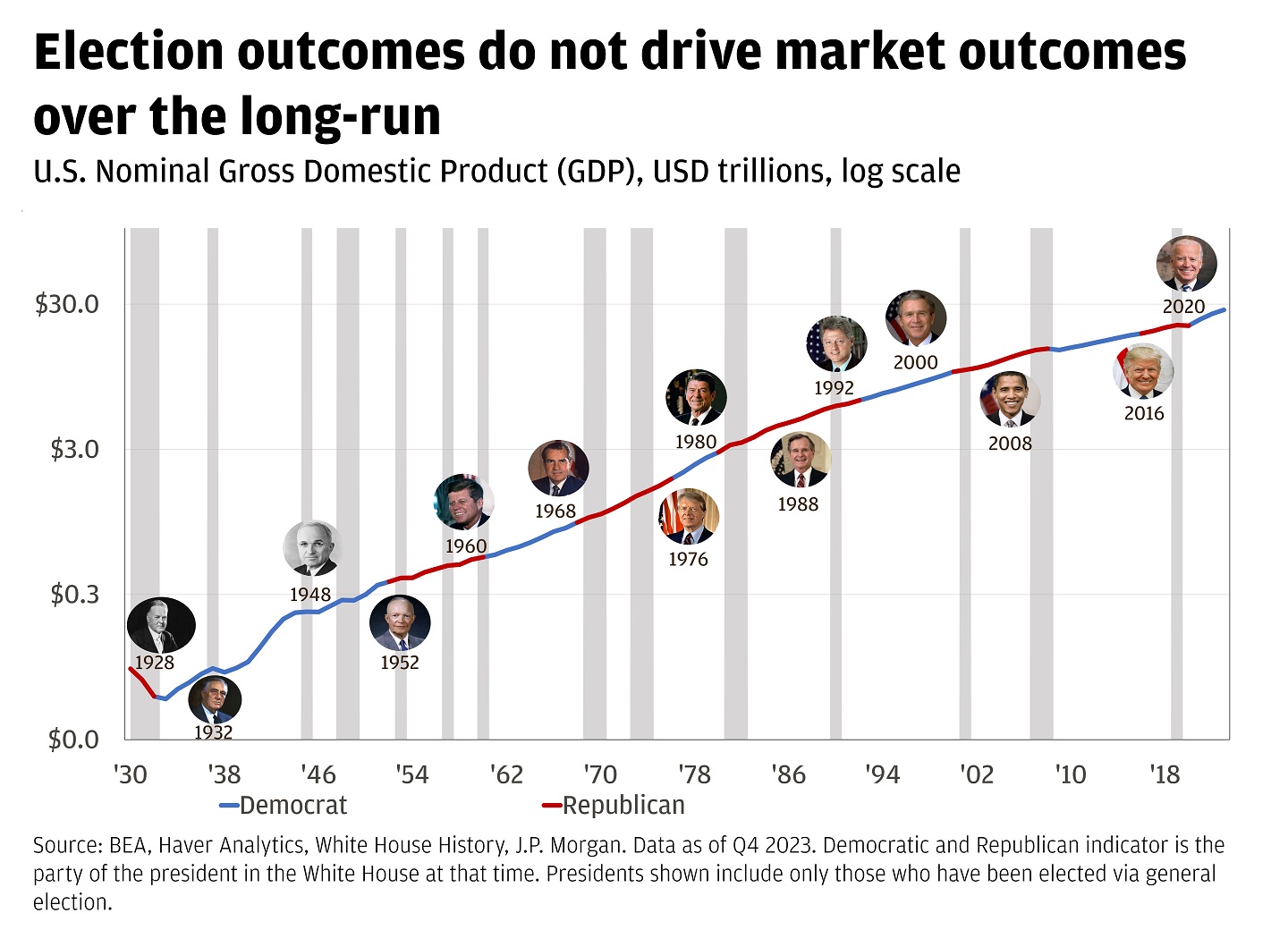
Contributors

Global Investment Strategist
T-minus 75 'til 2025: What every investor should know
The final countdown
This week, the S&P 500 hit its 46th all-time high of the year, as almost 10% of the index’s market cap released third-quarter earnings reports.
The results so far have been solid, with a deluge of major bank reports coming in above expectations. More than three-quarters of the companies that have reported so far have delivered positive surprises, with those companies beating expectations by 6.8% in the aggregate.
Throughout the week, the narrative surrounding AI’s major players diverged. ASML, the Dutch semiconductor supply chain stalwart, put pressure on chip industry stocks on Tuesday after it missed on earnings and revised down 2025 sales guidance. The report raised concerns about sustained demand. On a brighter note, Taiwan Semiconductor Manufacturing crushed analyst expectations, posting quarterly profits up over 50% from the prior year. They also raised full-year sales guidance, citing “robust” AI-related demand.
With investors increasingly focused on tangible results and carrying high expectations, third-quarter earnings season will continue to be a test for the big AI names.
Treasury yields fluctuated throughout the week but found clarity after two major macro releases: retail sales and jobless claims. Retail sales for September were strong across the board, beating consensus estimates on the month and well surpassing August’s numbers. Weekly jobless claims came in below estimates and continue to support signs that the labor market remains on steadier footing.
As a result, expectations for a less aggressive Federal Reserve easing cycle increased, and the 2-year Treasury moved net minus-one basis point through Thursday to 3.97%. Meanwhile, the 10-year was about flat at 4.09%.
There are 75 days until 2025, 20 days until the next Federal Reserve meeting, and 18 days until the U.S. presidential election (Halloween is 14 days away, but who’s counting?). As we approach the rest of the year’s market catalysts, we are eager to share three key considerations for portfolios, along with timely insights from our Chief Investment Officer (CIO) Richard Madigan’s most recent webcast. In the video, Richard discusses today’s portfolio positioning, key rotations year-to-date, the outlook heading into year-end, considerations around the geopolitical landscape and the importance of having a disciplined investment process.
3 principles every investor should know ahead of year-end
1. Practice good portfolio hygiene. Identifying your goals and creating a long-term plan are the first steps in practicing what you might call “good portfolio hygiene.” Like annual visits to the doctor, adding regular financial “check-ups” to the list is just as important. Why? Market and economic dynamics can shift in both the short and long term. This may lead to unexpected changes to your portfolio.
This week, the bull market celebrated its second “birthday.” Since hitting a low of 3,577 on October 12, 2022, the S&P 500 has posted a total return of more than 60% (so much for the “terrible twos” phase). For investors, those welcome-but-outsized gains might have thrown long-term asset allocations off-balance if left unchecked.
For example, take a basic 60/40 portfolio over the last year (60% invested in S&P 500 stocks and 40% in U.S. Bloomberg Aggregate Index bonds), which has notched an almost 27% total return. Without rebalancing, the same portfolio would now be overweight stocks at 64% and underweight in bonds at 36%, given the performance differential between the two asset classes.
Take some time to review your target asset mix and consider rebalancing. If necessary, trim oversized positions or add to underweighted ones to stay on track. By maintaining a balanced approach and adjusting your allocation as needed, investors can mitigate risks and take advantage of strategic opportunities.
For clients invested in CIO portfolios, this rebalancing has been taken care of for you. As Richard highlights in the webcast, CIO portfolios moved into overweight positions in stock and bond markets in the first quarter of this year, increased stock exposure during the sell-off in early August, and recently rebalanced back to neutral on market strength over the last two months. This shift was primarily valuation-driven, with potential geopolitical tail risks in mind, as well.
In addition to the stock bond mix, there have also been rotations within asset classes – right-sizing AI exposures, adjusting European allocations and leaning into health care – specifically into more opportunistic exposures like weight loss drugs. With a soft landing as the base case, the team is focused on diversifying risk while maintaining a pro-cyclical stance at the portfolio level, with significantly less downside risk than broad equity markets.

2. Understand the risks, but prepare for opportunity. In a market often driven by short-term news cycles, there is always something to worry about. We believe it’s crucial to maintain a long-term perspective and keep fundamentals top of mind.
Today, the upcoming U.S. presidential elections and geopolitical turmoil in the Middle East may be causing some investors unease. However, we do not think either should be cause to derail long-term investment plans.
Despite the buzz surrounding each candidate’s policy proposals, Richard reminds us that “campaign promises can be entertaining but are more salacious for the vote than impactful.” In other words, it is essential to focus on the “knowns” rather than the unknowns. Instead, we believe the most important implications are the resulting policies post-election and their outcomes, acknowledging that there is a difference between a short-term trade and a fundamental trend.
Remember, markets tend to notch gains no matter who is in office. Since 1950, there have been 18 presidential elections and 10 transitions in the White House between Democrats and Republicans. Over those 74 years, U.S. GDP growth has averaged a 3.2% annual pace, while the S&P 500 has compounded at 9.4% per year.
If market uncertainty has you second-guessing your portfolio allocation, welcome it as an opportunity to revisit your goals and plan. An advisor can help you make tweaks if necessary so that you can have the confidence to stay invested and reap the benefits of doing so.

3. Employ available tools to enhance portfolio efficiency. The integration of technology and innovation into investment strategies might enhance long-term portfolio performance.
Take for example, AI, which stands to augment the process behind active portfolio management. It may allow managers to gain a competitive edge through better data analysis and quicker decision-making. AI can also enhance more traditional strategies like tax-loss harvesting, which involves realizing losses in portfolios to offset gains. This can, in turn, reduce tax burdens in your portfolio.
At J.P. Morgan, we recognize AI as an important tool for today and beyond. We are dedicated to thoughtfully integrating technology to support our portfolio managers, ensuring it enhances portfolios responsibly and effectively.
Today’s market environment is complex.
These are just a few principles to guide investors through the next 75 days of 2024 and beyond. The insights shared by Richard remind us that while the market landscape may be ever-changing, a disciplined approach rooted in sound principles will always be essential. Start with the basics: Establish a mix of stocks and bonds that feel best for you and build from there.
As always, your J.P. Morgan advisor is here to help.
All market and economic data as of 10/18/2024 are sourced from Bloomberg Finance L.P. and FactSet unless otherwise stated.
Connect with a Wealth Advisor
Reach out to your Wealth Advisor to discuss any considerations for your current portfolio. If you don’t have a Wealth Advisor, click here to tell us about your needs and we’ll reach out to you.
DISCLOSURES
The information presented is not intended to be making value judgments on the preferred outcome of any government decision or political election.
There may be a potential tax implication with a rebalancing strategy. Please consult your tax advisor before implementing such a strategy.
Index definitions:
The Russell 3000 Index is a capitalization-weighted stock market index that seeks to be a benchmark of the entire U.S. stock market. It measures the performance of the largest 3,000 U.S. companies representing approximately 96% of the investable U.S. equity market.
The S&P 500 Equal Weight Index is the equal-weight version of the widely-used S&P 500. The index includes the same constituents as the capitalization weighted S&P 500, but each company in the S&P 500 EWI is allocated a fixed weight of the index total at each quarterly rebalance.
The Bloomberg U.S. Aggregate Bond Index is a broad-based flagship benchmark that measures the investment grade, US dollar-denominated, fixed-rate taxable bond market. The index includes Treasuries, government-related and corporate securities, MBS (agency fixed-rate pass-throughs), ABS and CMBS (agency and non-agency).
The Magnificent Seven stocks are a group of influential companies in the U.S. stock market: Alphabet, Amazon, Apple, Meta Platforms, Microsoft, NVIDIA, and Tesla.
The Magnificent 7 Index is an equal-dollar weighted equity benchmark consisting of a fixed basket of 7 widely-traded companies (Microsoft, Apple, Nvidia, Alphabet, Amazon, Meta, Tesla) classified in the United States and representing the Communications, Consumer Discretionary and Technology sectors as defined by Bloomberg Industry Classification System (BICS).
The S&P Midcap 400 Index is a capitalization-weighted index which measures the performance of the mid-range sector of the U.S. stock market.
The S&P 500 index is widely regarded as the best single gauge of large-cap U.S. equities and serves as the foundation for a wide range of investment products. The index includes 500 leading companies and captures approximately 80% coverage of available market capitalization.
Bonds are subject to interest rate risk, credit, call, liquidity and default risk of the issuer. Bond prices generally fall when interest rates rise.
Standard and Poor’s 500 Index is a capitalization-weighted index of 500 stocks. The index is designed to measure performance of the broad domestic economy through changes in the aggregate market value of 500 stocks representing all major industries. The index was developed with a base level of 10 for the 1941–43 base period.
The Bloomberg Eco Surprise Index shows the degree to which economic analysts under- or over-estimate the trends in the business cycle. The surprise element is defined as the percentage difference between analyst forecasts and the published value of economic data releases.
The MSCI World Index is a free float-adjusted market capitalization index that is designed to measure global developed market equity performance.
The NASDAQ 100 Index is a basket of the 100 largest, most actively traded U.S companies listed on the NASDAQ stock exchange. The index includes companies from various industries except for the financial industry, like commercial and investment banks. These non-financial sectors include retail, biotechnology, industrial, technology, health care, and others.
The Russell 2000 Index measures small company stock market performance. The index does not include fees or expenses.
We believe the information contained in this material to be reliable but do not warrant its accuracy or completeness. Opinions, estimates, and investment strategies and views expressed in this document constitute our judgment based on current market conditions and are subject to change without notice.
The views, opinions, estimates and strategies expressed herein constitutes the author's judgment based on current market conditions and are subject to change without notice, and may differ from those expressed by other areas of J.P. Morgan. This information in no way constitutes J.P. Morgan Research and should not be treated as such. You should carefully consider your needs and objectives before making any decisions. For additional guidance on how this information should be applied to your situation, you should consult your advisor.
All companies referenced are shown for illustrative purposes only, and are not intended as a recommendation or endorsement by J.P. Morgan in this context.
JPMorgan Chase & Co., its affiliates, and employees do not provide tax, legal or accounting advice. Information presented on these webpages is not intended to provide, and should not be relied on for tax, legal and accounting advice. You should consult your own tax, legal and accounting advisors before engaging in any financial transaction.
RISK CONSIDERATIONS
- Past performance is not indicative of future results. You may not invest directly in an index.
- The price of equity securities may rise or fall due to the changes in the broad market or changes in a company's financial condition, sometimes rapidly or unpredictably. Equity securities are subject to 'stock market risk' meaning that stock prices in general may decline over short or extended periods of time.
- Investing in fixed income products is subject to certain risks, including interest rate, credit, inflation, call, prepayment and reinvestment risk. Any fixed income security sold or redeemed prior to maturity may be subject to substantial gain or loss.
- In general, the bond market is volatile and bond prices rise when interest rates fall and vice versa. Longer term securities are more prone to price fluctuation than shorter term securities. Any fixed income security sold or redeemed prior to maturity may be subject to substantial gain or loss. Dependable income is subject to the credit risk of the issuer of the bond. If an issuer defaults no future income payments will be made.
- When investing in mutual funds or exchange-traded and index funds, please consider the investment objectives, risks, charges, and expenses associated with the funds before investing. You may obtain a fund’s prospectus by contacting your investment professional. The prospectus contains information, which should be carefully read before investing.
- Investors should understand the potential tax liabilities surrounding a municipal bond purchase. Certain municipal bonds are federally taxed if the holder is subject to alternative minimum tax. Capital gains, if any, are federally taxable. The investor should note that the income from tax-free municipal bond funds may be subject to state and local taxation and the alternative minimum tax (amt).
- International investments may not be suitable for all investors. International investing involves a greater degree of risk and increased volatility. Changes in currency exchange rates and differences in accounting and taxation policies outside the U.S. can raise or lower returns. Some overseas markets may not be as politically and economically stable as the united states and other nations. Investments in international markets can be more volatile.
- Investments in emerging markets may not be suitable for all investors. Emerging markets involve a greater degree of risk and increased volatility. Changes in currency exchange rates and differences in accounting and taxation policies outside the U.S. can raise or lower returns. Some overseas markets may not be as politically and economically stable as the united states and other nations. Investments in emerging markets can be more volatile.
- Investments in commodities may have greater volatility than investments in traditional securities, particularly if the instruments involve leverage. The value of commodity-linked derivative instruments may be affected by changes in overall market movements, commodity index volatility, changes in interest rates, or factors affecting a particular industry or commodity, such as drought, floods, weather, livestock disease, embargoes, tariffs and international economic, political and regulatory developments. Use of leveraged commodity-linked derivatives creates an opportunity for increased return but, at the same time, creates the possibility for greater loss.
- Real estate investments trusts may be subject to a high degree of market risk because of concentration in a specific industry, sector or geographical sector. Real estate investments may be subject to risks including, but not limited to, declines in the value of real estate, risks related to general and economic conditions, changes in the value of the underlying property owned by the trust and defaults by borrower.
- Investment in alternative investment strategies is speculative, often involves a greater degree of risk than traditional investments including limited liquidity and limited transparency, among other factors and should only be considered by sophisticated investors with the financial capability to accept the loss of all or part of the assets devoted to such strategies.
- Structured products involve derivatives and risks that may not be suitable for all investors. The most common risks include, but are not limited to, risk of adverse or unanticipated market developments, issuer credit quality risk, risk of lack of uniform standard pricing, risk of adverse events involving any underlying reference obligations, risk of high volatility, risk of illiquidity/little to no secondary market, and conflicts of interest. Before investing in a structured product, investors should review the accompanying offering document, prospectus or prospectus supplement to understand the actual terms and key risks associated with the each individual structured product. Any payments on a structured product are subject to the credit risk of the issuer and/or guarantor. Investors may lose their entire investment, i.e., incur an unlimited loss. The risks listed above are not complete. For a more comprehensive list of the risks involved with this particular product, please speak to your J.P. Morgan team.
- As a reminder, hedge funds (or funds of hedge funds) often engage in leveraging and other speculative investment practices that may increase the risk of investment loss. These investments can be highly illiquid, and are not required to provide periodic pricing or valuation information to investors, and may involve complex tax structures and delays in distributing important tax information. These investments are not subject to the same regulatory requirements as mutual funds; and often charge high fees. Further, any number of conflicts of interest may exist in the context of the management and/or operation of any such fund. For complete information, please refer to the applicable offering memorandum.
- For informational purposes only -- J.P. Morgan Securities LLC does not endorse, advise on, transmit, sell or transact in any type of virtual currency. Please note: J.P. Morgan Securities LLC does not intermediate, mine, transmit, custody, store, sell, exchange, control, administer, or issue any type of virtual currency, which includes any type of digital unit used as a medium of exchange or a form of digitally stored value.
- The prices and rates of return are indicative, as they may vary over time based on market conditions.
- Additional risk considerations exist for all strategies.
- The information provided herein is not intended as a recommendation of or an offer or solicitation to purchase or sell any investment product or service.
- Opinions expressed herein may differ from the opinions expressed by other areas of J.P. Morgan. This material should not be regarded as investment research or a J.P. Morgan investment research report.
This material is for information purposes only, and may inform you of certain products and services offered by J.P. Morgan’s wealth management businesses, part of JPMorgan Chase & Co. (“JPM”). The views and strategies described in the material may not be suitable for all investors and are subject to investment risks. Please read all Important Information.
GENERAL RISKS & CONSIDERATIONS. Any views, strategies or products discussed in this material may not be appropriate for all individuals and are subject to risks. Investors may get back less than they invested, and past performance is not a reliable indicator of future results. Asset allocation/diversification does not guarantee a profit or protect against loss. Nothing in this material should be relied upon in isolation for the purpose of making an investment decision. You are urged to consider carefully whether the services, products, asset classes (e.g. equities, fixed income, alternative investments, commodities, etc.) or strategies discussed are suitable to your needs. You must also consider the objectives, risks, charges, and expenses associated with an investment service, product or strategy prior to making an investment decision. For this and more complete information, including discussion of your goals/situation, contact your J.P. Morgan team.
NON-RELIANCE. Certain information contained in this material is believed to be reliable; however, JPM does not represent or warrant its accuracy, reliability or completeness, or accept any liability for any loss or damage (whether direct or indirect) arising out of the use of all or any part of this material. No representation or warranty should be made with regard to any computations, graphs, tables, diagrams or commentary in this material, which are provided for illustration/reference purposes only. The views, opinions, estimates and strategies expressed in this material constitute our judgment based on current market conditions and are subject to change without notice. JPM assumes no duty to update any information in this material in the event that such information changes. Views, opinions, estimates and strategies expressed herein may differ from those expressed by other areas of JPM, views expressed for other purposes or in other contexts, and this material should not be regarded as a research report. Any projected results and risks are based solely on hypothetical examples cited, and actual results and risks will vary depending on specific circumstances. Forward-looking statements should not be considered as guarantees or predictions of future events.
Nothing in this document shall be construed as giving rise to any duty of care owed to, or advisory relationship with, you or any third party. Nothing in this document shall be regarded as an offer, solicitation, recommendation or advice (whether financial, accounting, legal, tax or other) given by J.P. Morgan and/or its officers or employees, irrespective of whether or not such communication was given at your request. J.P. Morgan and its affiliates and employees do not provide tax, legal or accounting advice. You should consult your own tax, legal and accounting advisors before engaging in any financial transactions.
LEGAL ENTITY, BRAND & REGULATORY INFORMATION
In the United States, bank deposit accounts and related services, such as checking, savings and bank lending, are offered by JPMorgan Chase Bank, N.A. Member FDIC.
J.P. Morgan Wealth Management is a business of JPMorgan Chase & Co., which offers investment products and services through J.P. Morgan Securities LLC (JPMS), a registered broker-dealer and investment adviser, member FINRA and SIPC. Insurance products are made available through Chase Insurance Agency, Inc. (CIA), a licensed insurance agency, doing business as Chase Insurance Agency Services, Inc. in Florida. Certain custody and other services are provided by JPMorgan Chase Bank, N.A. (JPMCB). JPMS, CIA and JPMCB are affiliated companies under the common control of JPMorgan Chase & Co. Products not available in all states.
Bank deposit accounts and related services, such as checking, savings and bank lending, are offered by JPMorgan Chase Bank, N.A. Member FDIC.
This document may provide information about the brokerage and investment advisory services provided by J.P. Morgan Securities LLC (“JPMS”). The agreements entered into with JPMS, and corresponding disclosures provided with respect to the different products and services provided by JPMS (including our Form ADV disclosure brochure, if and when applicable), contain important information about the capacity in which we will be acting. You should read them all carefully. We encourage clients to speak to their JPMS representative regarding the nature of the products and services and to ask any questions they may have about the difference between brokerage and investment advisory services, including the obligation to disclose conflicts of interests and to act in the best interests of our clients.
J.P. Morgan may hold a position for itself or our other clients which may not be consistent with the information, opinions, estimates, investment strategies or views expressed in this document. JPMorgan Chase & Co. or its affiliates may hold a position or act as market maker in the financial instruments of any issuer discussed herein or act as an underwriter, placement agent, advisor or lender to such issuer.








